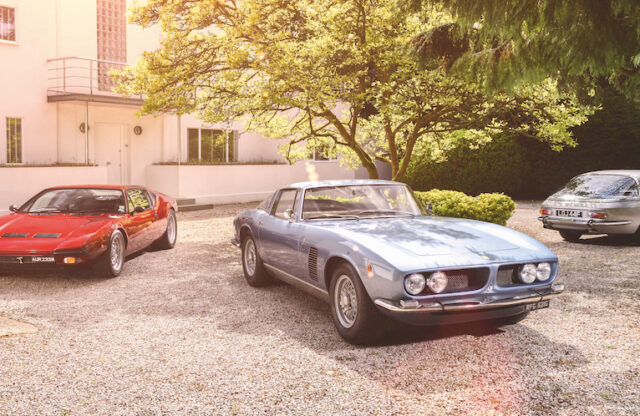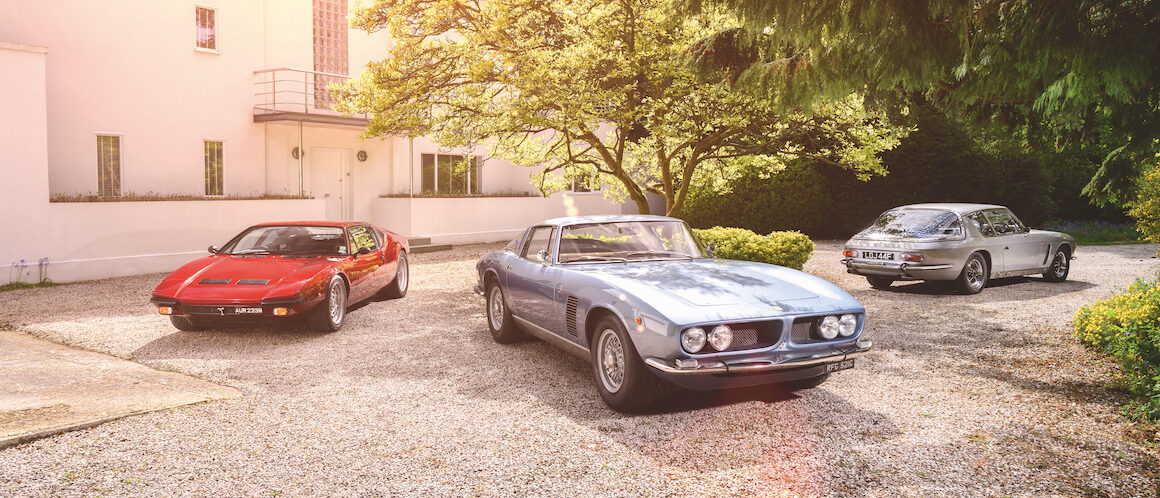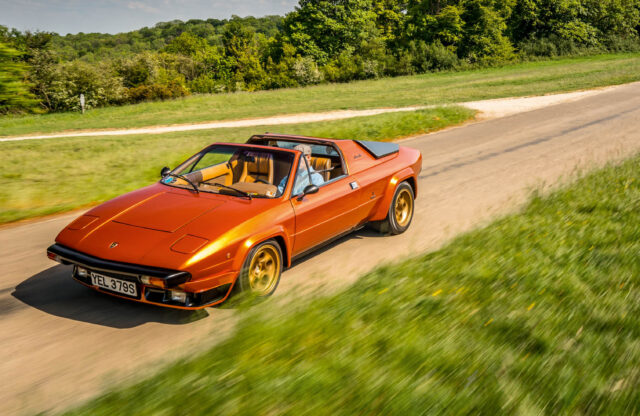Three cars styled by Italian coachbuilders and powered by American V8s, and yet each very different in character. Individual takes on the GT theme from De Tomaso, Iso and Jensen
Hybrid cars are big news right now. With fuel-efficient petrol engines backed up by electric motors, they’re an acceptable compromise as we transition away from the age of Big Oil to… well, whatever the future may hold. But the three cars featured here are a different kind of hybrid. As Jay Leno once quipped in his Octane column, ‘I like to tell people I drive a hybrid – around town it runs on gas, and when I get on the freeway it runs on more gas.’
And yes, all of this trio will use plenty of gas or petrol, depending on your country of birth. But actually they are hybrids in that each marries Italian design with an American V8, and they represent the flowering of an automotive genus that first blossomed in the 1950s and fully bloomed in the late 1960s and early ’70s. In order of appearance, they are the Iso Grifo, Jensen Interceptor and De Tomaso Pantera.
The practice of shoehorning a big US engine into a European package dates back to before World War Two (Railton being one example); then, during the 1950s, American manufacturers such as Chrysler turned to Italian stylists to inject a bit of flair into their show-car concepts. Limited runs of two-door luxury sedans such as the Dual-Ghia and Hudson Italia followed on. But it was in the 1960s that the Italo-American hybrid really took off, in the form of beautiful coupés that offered the glamour and performance of an Aston or Maserati with ‘Yank tank’ reliability.
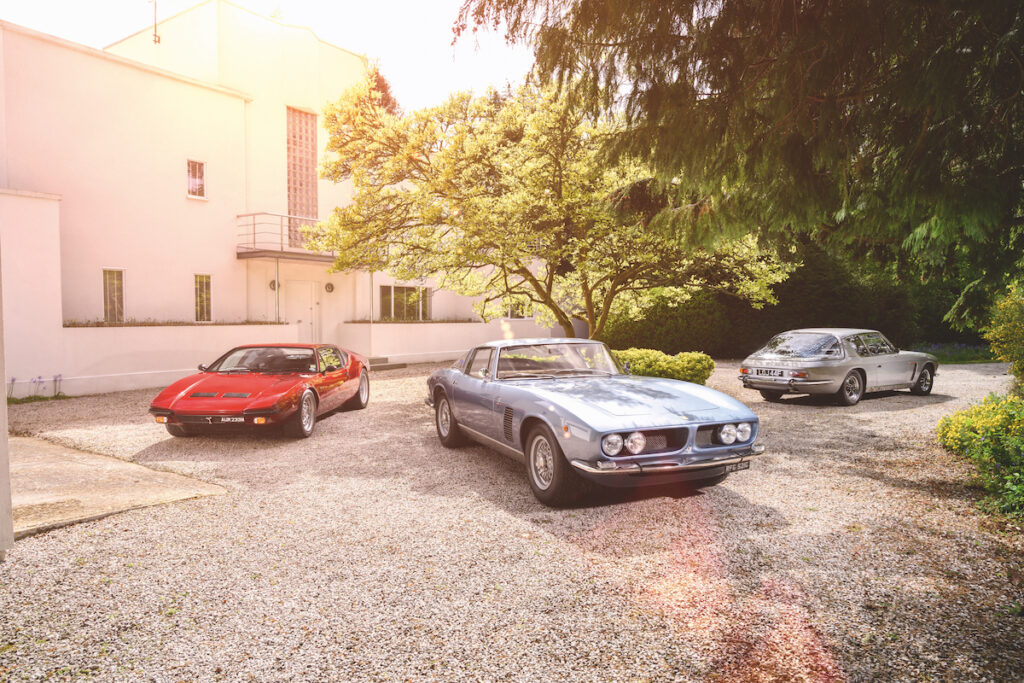
Our three feature cars are all variations on that theme.
We Brits are most familiar with the Jensen, which sold in comparatively big numbers and for a long period: 6408 cars over 11 years, 1966-76. The styling was by carrozzeria Touring, although cars were initially assembled by Vignale, and motive power was courtesy of a Chrysler V8. The Pantera, in contrast, was very much a US phenomenon, designed by Ghia’s Tom Tjaarda, powered by Ford and actually sold through Ford’s Lincoln-Mercury dealerships for a few years. Like the Interceptor, the Pantera was a sales success, notching up around 7200 units over a remarkable 1971-92 production run.
And then there’s the Grifo. For sheer, unadulterated Italian glamour, this car is in a league of its own. Giorgetto Giugiaro, then at Bertone, penned a car that combined the elegance of a Ferrari with the drama of a Lamborghini, yet the horsepower of a Chevrolet Corvette. It’s by far the rarest car here, with a little over 400 examples built during 1963-74. But is it the most desirable to drive?
As arguably the most ‘sensible’ of our trio, it seems natural to begin with the Jensen. This 1967 Mk1 is one of the first to have been built in the UK after Jensen moved production away from Vignale. Owner Nigel McMorrin is only its second keeper; he bought it in 2005 and – other than an engine rebuild to rectify the effects of years of dis-use – has needed to do little other than have the wheels refurbished. ‘I’ve also fitted Jaguar E-type front discs and calipers,’ he adds. ‘It had Dunlop discs originally but the pad contact area was about the size of a 50p piece and you had to look six cars ahead to achieve an emergency stop.’
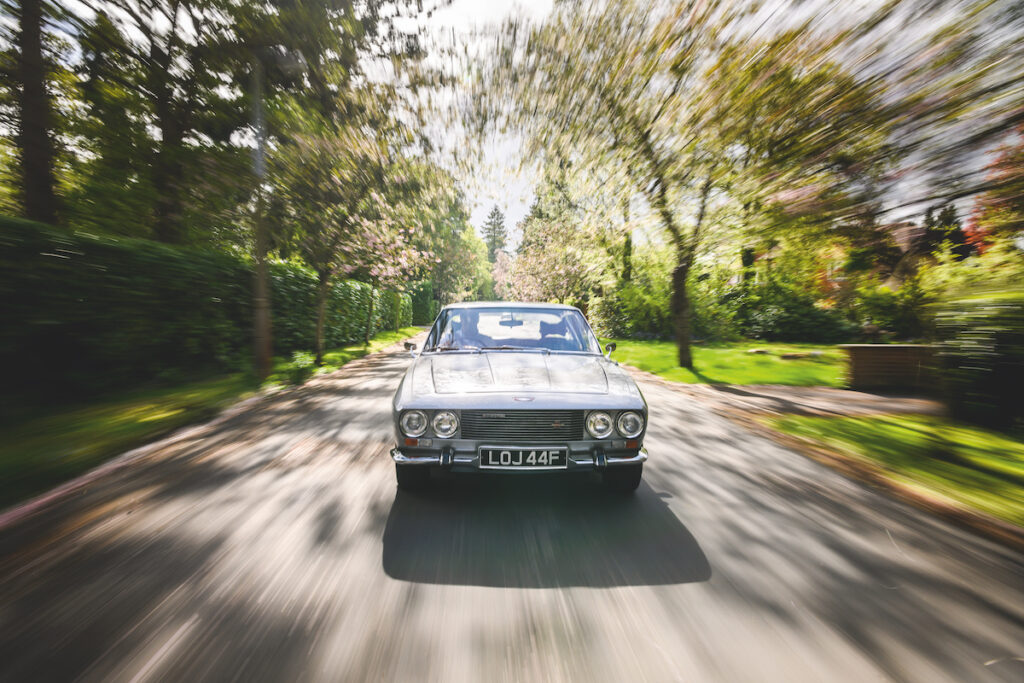
As you can see from the pictures, the Interceptor makes a convincing fist of playing the Italian exotic, with its Miura-style deeply cowled instruments and large Nardi-lookalike wheel. And if you’d never driven an Interceptor before, this is how you might have imagined it. Soft, comfy leather seats; evocative view over those big, chrome-rimmed dials and through that huge ’screen; gently burbling V8 and slurring autobox. The Jensen feels quick rather than supercar-fast – although an Autocar-tested 0-60mph time of 7.3sec was more than respectable in 1967 – but that’s no criticism. This car is all about travelling in understated style and comfort, where speed is only part of the equation.
Nigel has had power steering fitted to this originally non-PAS example but something’s not quite right. The car feels directionally vague and, while it’s tempting to wind-up Octane’s Interceptor-owning editor James and claim that ‘they’re all like that’, it’s not actually true.
Otherwise, however, it’s a total delight, especially so in terms of its ride quality: here the Jensen scores well by feeling pleasantly supple, whether travelling fast or slow. And it’s the ‘slow’ bit that’s important; a true GT should cosset its occupants in towns and cities, as well as when fanging down the motorway.
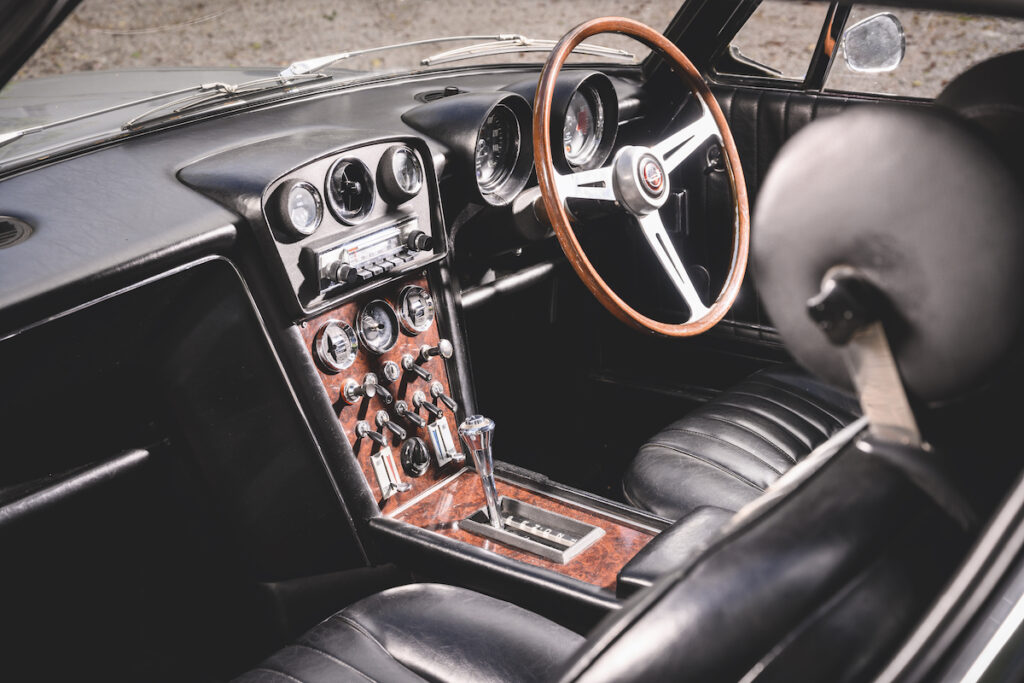
Bottom line is that you really could live with this car as a daily driver, even now, more than half-a-century after it was made – and that’s why there have been various upgraded Interceptor ‘new builds’ from companies such as Cropredy Bridge Garage and Jensen International Automotive that offer the more powerful engines today’s buyers seem to want. Love or loathe Jeremy Clarkson, he had it exactly right when, after testing a JIA-built Interceptor R, he wrote: ‘You don’t need a radio because at every single set of lights someone will knock on the window to tell you what a lovely car you are driving.’
Buyers clearly felt the same way back in the day because the Interceptor was a great success for Jensen, even if, ultimately, it couldn’t save the company from the world recession precipitated by the 1973-74 oil crisis. Engine size was increased to 7.2 litres in 1971 (the four-wheel-drive FF only ever had the ‘383’), the same year in which the 232 SP models – for ‘Six Pack’ – were built. With three twin-choke carburettors, the SP was the most powerful version, though never badged as an Interceptor. There were other variations on the theme including a convertible and a rare notchback coupé, but the basic car didn’t change much. Even the performance stayed broadly the same, emissions-control equipment offsetting greater cylinder capacity.
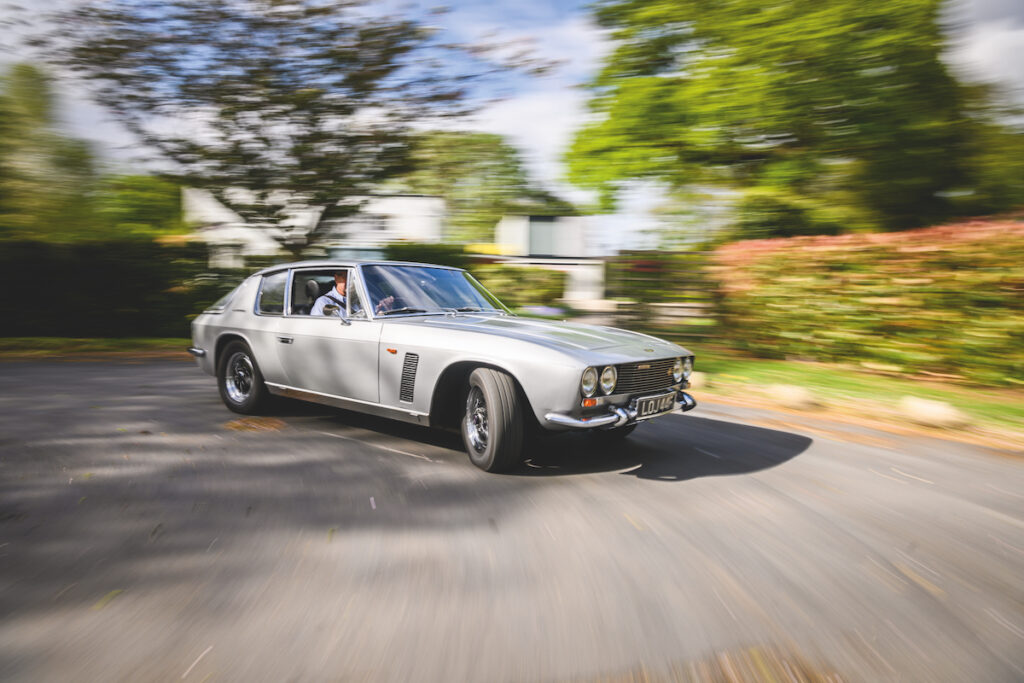
Besides complimenting you on your choice of car when driving the Jensen, chances are that bystanders would at least vaguely recognise the name, if not the shape. But the proverbial man on the Clapham omnibus, peering down at an Iso Grifo, would have to be exceptionally well informed about Italian exotica to have a clue what it was. Unless, that is, he owned the Matchbox model as a child, which is the closest that most Brits ever came to seeing a Grifo.
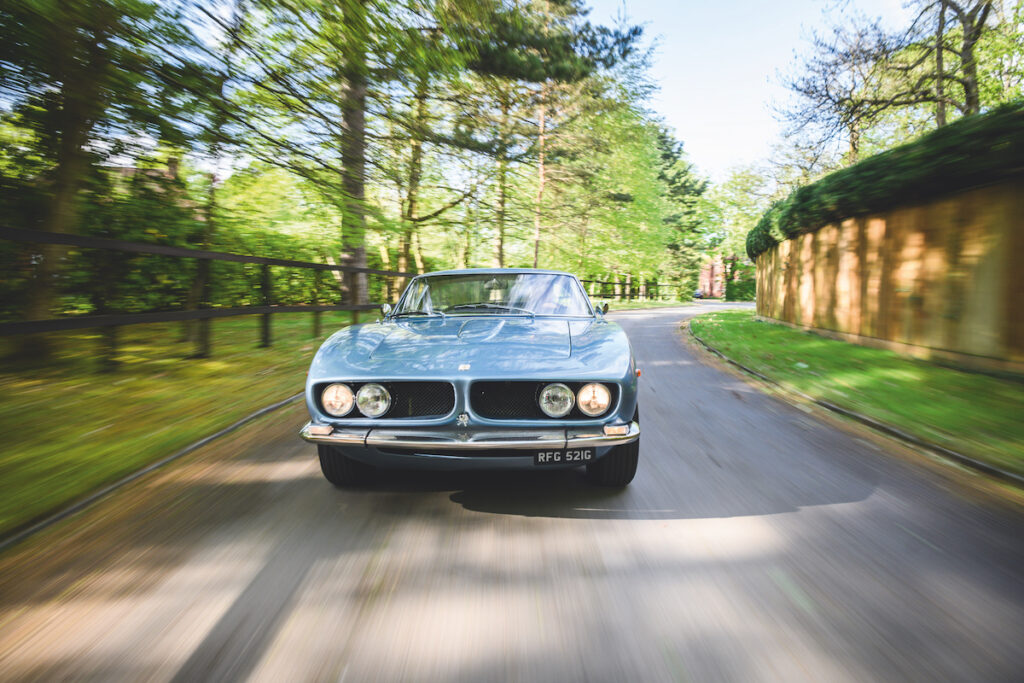
It was a memory of the Matchbox toy that inspired the previous owner of our car to buy it: a Hungarian PR company owner, who particularly wanted a light blue Grifo like the Matchbox version, and one made in 1968, the year of his birth. He bought this one from a German car dealer because it was well priced, albeit red and made in 1969 – only to find, after he’d taken delivery, that the car was originally light blue and in fact a 1968 example. You can see an excellent video about this very car on YouTube: search for ‘Iso Grifo, a personal favorite’. Bizzarrini and Iso specialist Roberto Negri carried out a concours-quality restoration to put it back to 1968 specification.
The two names, Bizzarrini and Iso, are inextricably linked when you talk about the Grifo, because this model was always intended to be built as two versions: race and road. In fact, when the car made its debut at the 1963 Turin show, the road car was displayed on the Bertone stand and it was the competition model that appeared – in bare alloy, ‘engine turned’ with wine corks because there was no time to paint it, reputedly – on Iso’s own stand. Giotto Bizzarrini designed the chassis for both and initially built the competition version, the A3/C (for Corsa), with Renzo Rivolta’s blessing, but parted company with Iso in 1965 and went on to develop the A3/C as a Bizzarrini. In due course it became the Bizzarrini 5300, severing all ties with the Iso name.
Talking of which… Iso was acquired by Renzo before World War Two as Isothermos (literally, ‘constant temperature), a company making heating and cooling devices, but Renzo steered it post-war from producing back-to-basics motorcycles and scooters, via the Isetta bubble-car, to its first Grand Tourer in 1962, the handsome if somewhat strait-laced Iso Rivolta GT. The Grifo that appeared the following year was another kind of animal: wider, more voluptuous, essentially a whole lot sexier than the rather understated Rivolta GT. Less Audrey Hepburn in Roman Holiday, more Sophia Loren in Arabesque.
Like its predecessor, the Grifo used Chevrolet Corvette power; our feature car began life with the entry-level 300bhp, 327ci V8, which was upgraded at some point to the optional 365bhp state-of-tune – you could buy Grifos with a variety of 327ci motors, and there was also a monster 427ci (7.0-litre) version, which is easily recognised by an elevated flat panel on the bonnet that looks for all the world as though someone has just rested a sheet of plasterboard on top. Series II cars, built from 1970, had the headlights partly shielded by pop-up covers in an attempt to keep up with the more streamlined, pointy aesthetics of the new decade, and the last few Grifos built up to 1974 had Ford 351ci (5.7-litre) V8s after management changes meant that Chevrolet became increasingly difficult to deal with.
But, as so often is the case, the earliest version is the purest, and our feature car is a sublime example. Current owner Dominic Lester acquired it in September last year; as a child growing up in Italy, he remembers his father – a film producer at the Cinecittà studios in Rome – aspiring to own a Grifo but having to compromise with a Fiat Dino.
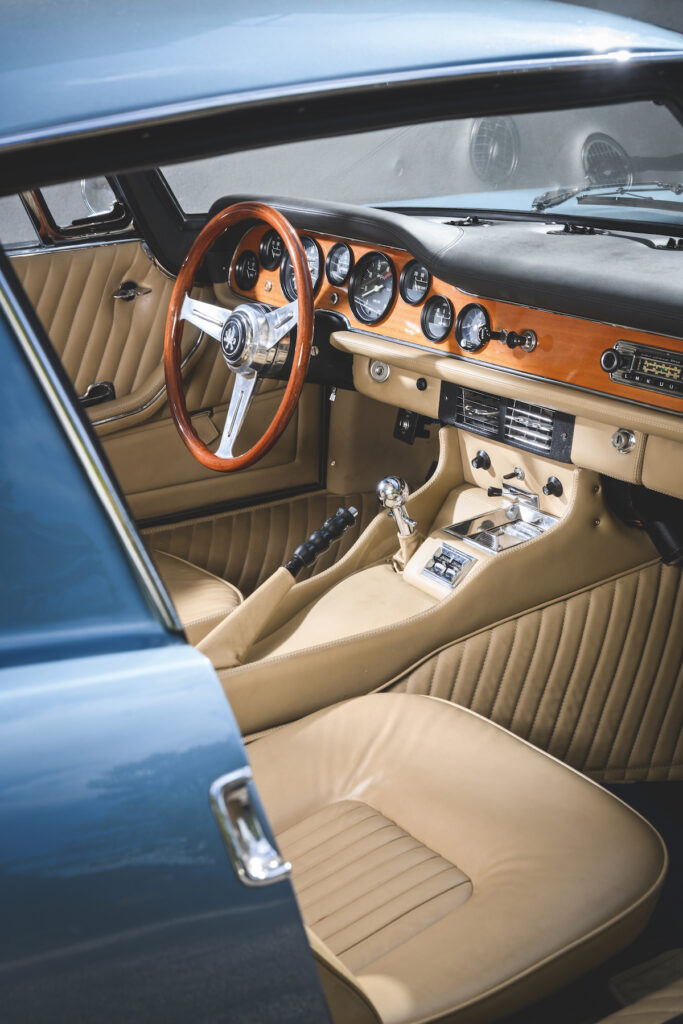
Dominic’s Grifo is a big, bold car and it responds best to big, bold gestures. In many ways it reminds me of the Lamborghini Espada that I used to share with Octane contributor Richard Heseltine: it really only comes into its own when you’re pushing hard. Yes, you can trundle it around town, but its heavy manual gearchange, impression of width (from the inside, at least) and firm-ish ride are all hints that this car is happiest on a flowing, open road.
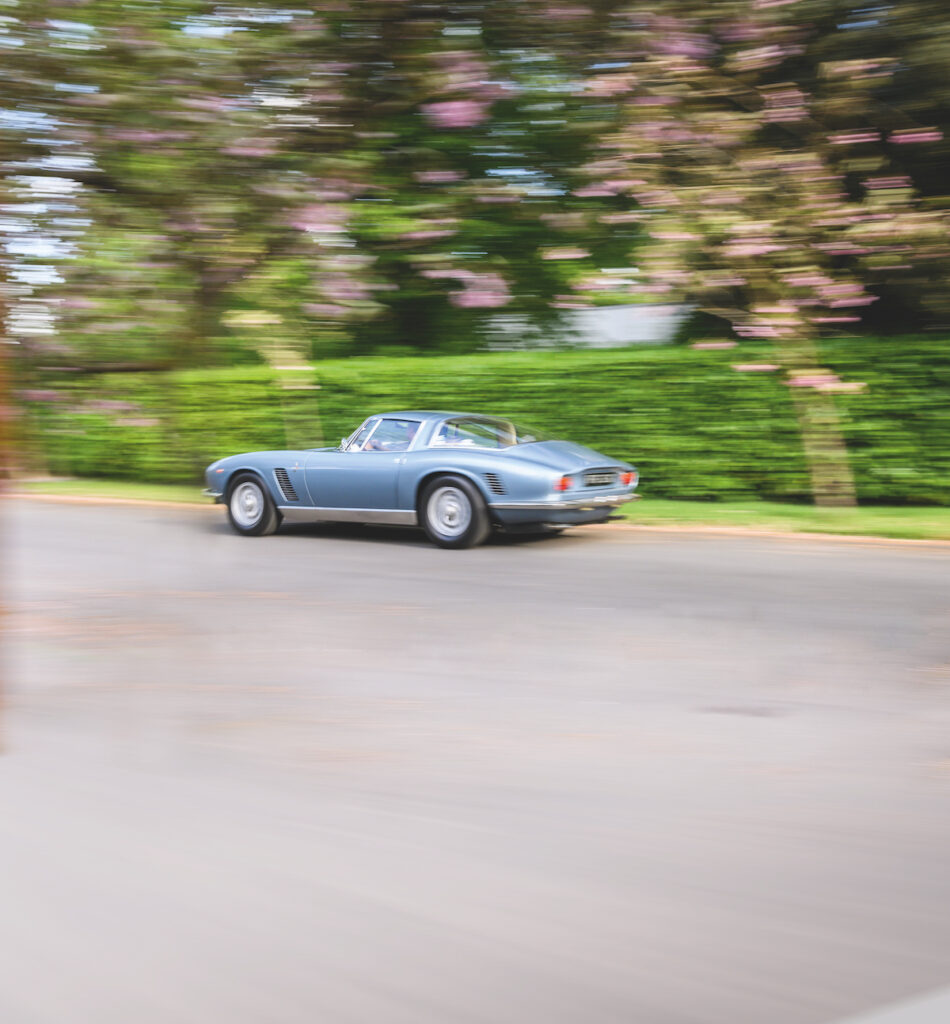
The Corvette-sourced V8 is beautifully refined, too, smooth and turbine-like, with no trace of the blue-collar V8 beat you might expect. As you lean on it, the exhaust note hardens into a thrilling snarl (which is best appreciated by watching the aforementioned YouTube video) but it stays well modulated and aristocratic in tone as the revs keep rising and the power builds. Yet the car’s wide track and low stance contribute to a reassuring sense of stability and it always feels well planted on the road, aided by wide-for-the-time Pirelli Cinturato 205-section tyres, and the power-assisted steering is pleasantly weighted.
However sexist it may sound now – and there’s no doubt it does – the Grifo was a car built for ‘real men’, 1960s-style.Alejandro de Tomaso’s Pantera was also aimed at real men, but men who couldn’t punch at the same financial weight as those who could afford a Grifo. By aligning himself with Ford, de Tomaso was able to benefit from Ford’s marketing clout to sell Panteras; by acquiring Vignale and its modern factory, he was able to produce them quickly enough to sell. The Pantera notched up over 3000 sales in its first two full years, 1971-72, aided by a Stateside retail price that was just over one-third of what a Miura or Bora cost.
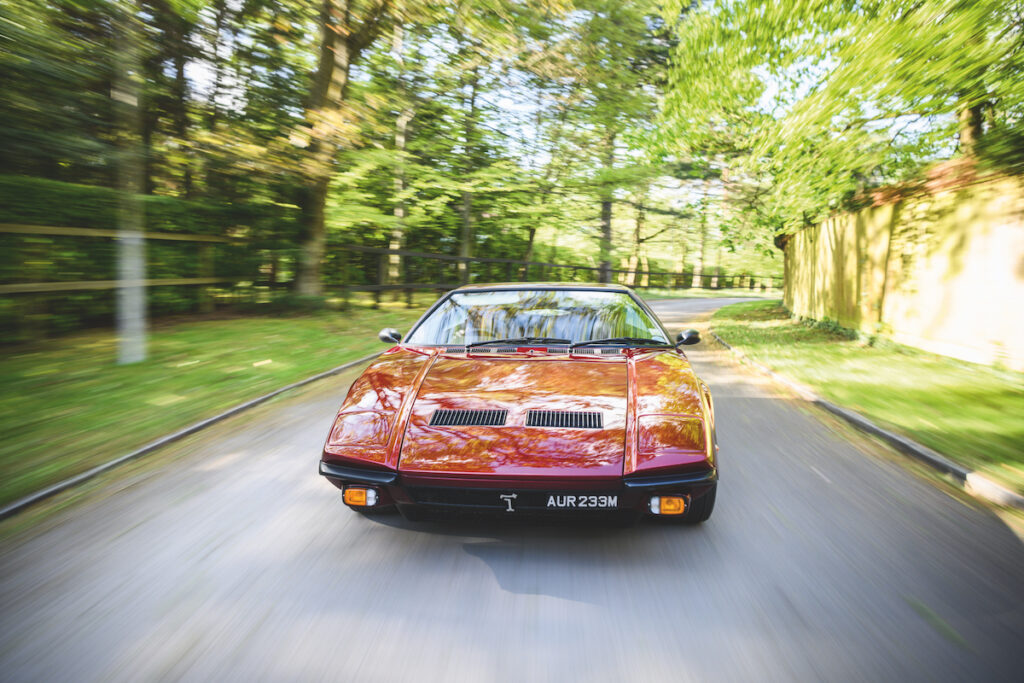
Stylistically, the Pantera appears not just to be from a different generation to the Interceptor and Grifo, but almost a different planet, Ghia designer Tom Tjaarda given free rein to pen a shape that would have seemed perfectly at home in the Space: 1999 TV series. And yet it was actually a more conventional car than the model it superseded, the Giugiaro-styled Mangusta, which had back-to-back gullwing covers for the engine compartment. Tjaarda himself recalled that his brief for the Pantera was ‘to design a new version of the Mangusta, which would be more comfortable and cheaper. [De Tomaso] gave me the chassis, which was great as it had been designed by Dallara, and I had to “get a car out of it”.’
One of the Pantera’s defining characteristics is the size difference between front and rear tyres (also true of the Mangusta). Originally Panteras wore 15in rims shod with 225/50s at the front and 285/50s at the rear, but our feature car has replica-style 16in fronts and 17in rears. That’s very typical of Panteras, and not just because of past difficulties in obtaining original-size tyres: Pantera owners have long been happy to modify their cars to individual taste.
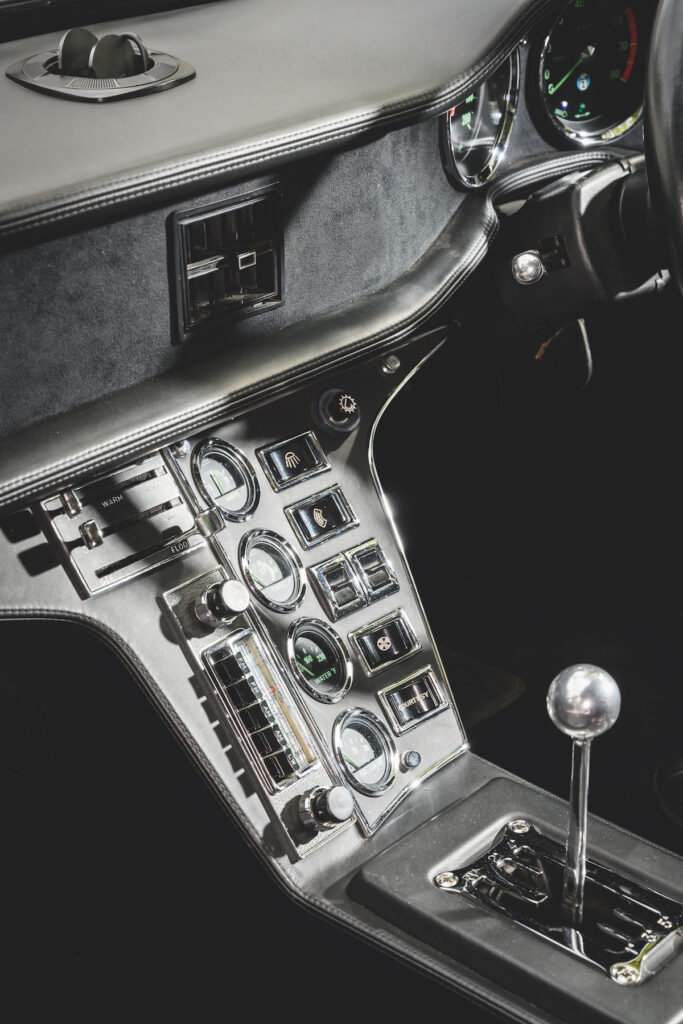
Owner of this 1973 example, Johnny Woods, is no exception, although his mods are subtle compared to some. This Pantera looks just right in its metallic burgundy paint, for example, and yet it’s a custom-car shade called Candy Brandy. Johnny restored the car himself, learning as he went along, and was so dedicated that he took shift work in a chipboard factory so that he could spend the rest of each day working on it. Not only did he fabricate a large amount of the steel body by hand, but he taught himself to retrim
the seats in leather. Literally every part has been rebuilt by Johnny himself, right down to the revcounter.
Not surprisingly, then, Johnny has tweaked some aspects of the Pantera design where he thought it would benefit. The Ford ‘Cleveland’ 351ci V8 has been mildy uprated to give about 350bhp – ‘although it could really use another 200’ – and the brakes have been upsized with aftermarket Wilwood parts; ‘the originals were positively dangerous’, explains Johnny. He’s also modified the front upper wishbones to give increased castor, for greater stability at speed, a change that has become so popular that US owners now send him their components to alter.
Such changes accentuate the Pantera’s particular character, but in truth it was always a very different kind of car from the Interceptor and Grifo – and not just because it’s mid/rear-engined. It feels a lot more compact inside, and the steering wheel is offset towards the centre-line of the car compared with the pedals. Curiously enough, from the outside it has the thunderous V8 engine note you rather expect, and yet inside it’s relatively quiet – not as subdued as the other cars here, but not intrusively noisy, either.
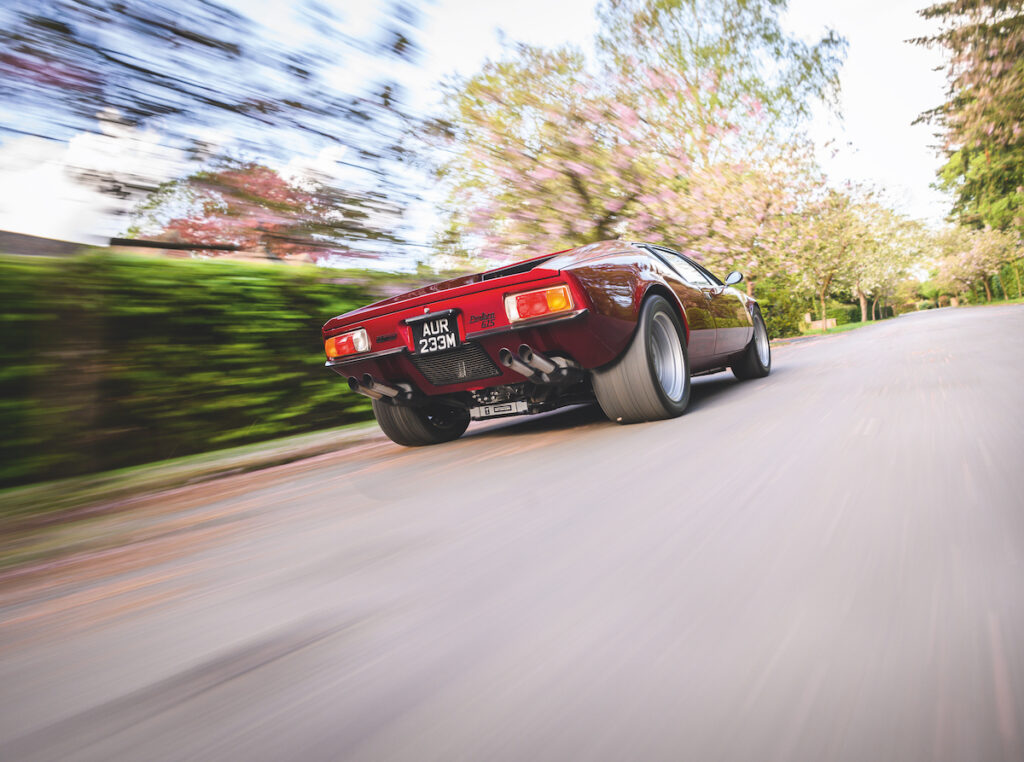
The gearbox is a manual ZF five-speed (same as a GT40’s and an BMW M1 race car’s, apparently), inverted to give greater ground clearance, and the shift has a very Italianate chromed gate, guiding the tall-ish lever through a dogleg-first pattern. Compared with the Grifo’s stubby, chunky item, the Pantera’s lever feels thin and almost delicate: they have been known to wear away and snap after years of being manipulated through that metal gate…
We can believe it, because the Pantera is addictive to drive. Even more so than the Grifo, it demands to be worked hard, its direct steering, firm suspension and compact dimensions contributing to a go-kart sensation. And it’s fast: you feel this Pantera, driven with commitment, could hold its own against many of today’s performance cars, although you’d want a dry day to prove it, since the light
rear end and big tyre contact patch are likely to bring out a somewhat skittish nature in the wet.
Alejandro de Tomaso made his name building sports and racing cars before he got into GTs; the Jensen Interceptor came out of a background of luxury sports tourers; the Iso Grifo had its roots in a family tree of scooters and bubble-cars. Three very different lineages resulted in three very different GTs, and attempting to define which is ‘best’ is an utterly pointless exercise.
Even with that caveat, however, the Jensen Interceptor deserves a special mention for punching above its weight here. It’s the least expensive car to buy now, and yet also the most usable, while sacrificing nothing in the way of glamour. (And no, I’m not just saying that because the editor owns one.) Me? I’d still take the Grifo, given access to the thick end of half-a-million sterling. Sadly, that’s the cross that we would-be Grifo owners have always had to bear.
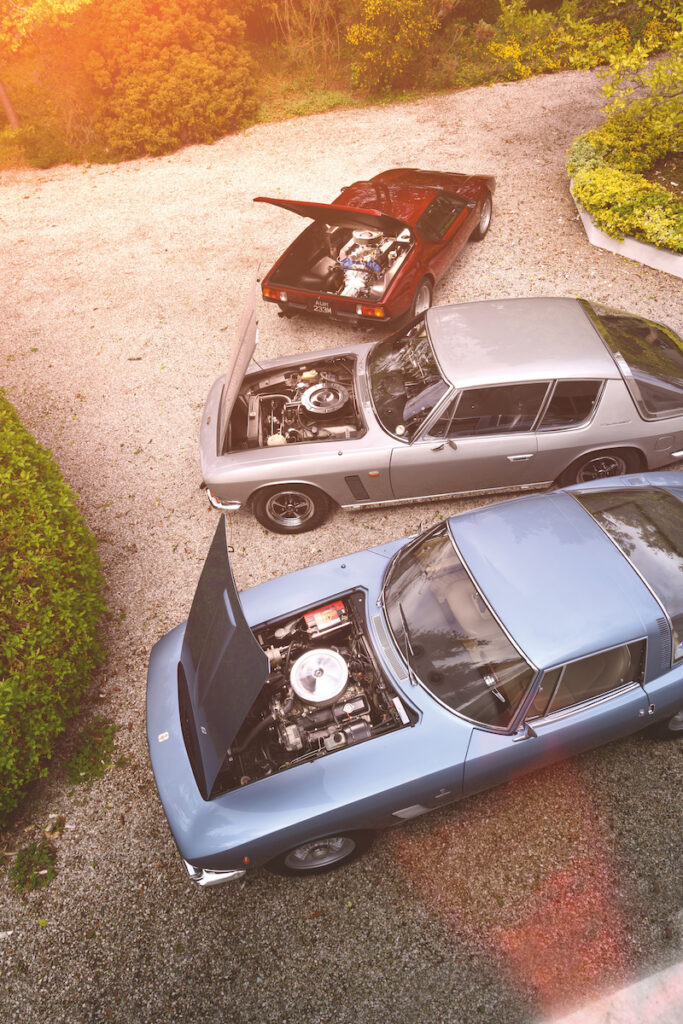
Factfile – 1973 De Tomaso Pantera GTS
Engine 5750cc Ford V8, Autolite four-barrel carburettor Power 310bhp @ 5400rpm Torque 301lb ft @ 3600rpm Transmission Five-speed manual, rear-wheel drive Steering Rack and pinion Suspension Front and rear: double wishbones, coil springs, telescopic dampers, anti-roll bars Brakes Girling discs Weight 1438kg Top speed c160mph 0-60mph 5.5sec
Factfile – 1968 Iso Grifo GL300
Engine 5358cc Chevrolet V8, Carter four-barrel carburettor Power 300bhp @ 6000rpm Torque 344lb ft @ 4000rpm Transmission Four-speed manual, rear-wheel drive Steering Recirculating ball Suspension Front: double wishbones, coil springs, telescopic dampers, anti-roll bar. Rear: de Dion tube, coil springs, telescopic dampers Brakes Dunlop discs Weight c1600kg Top speed 161mph 0-60mph 7.4sec
Factfile – 1967 Jensen Interceptor Mk1
Engine 6276cc Chrysler V8, OHV, Carter four-barrel carburettor Power 325bhp @ 4600rpm Torque 425lb ft @ 2800rpm Transmission Four-speed manual (22 cars) or three-speed Chrysler Torqueflite automatic, rear-wheel drive Steering Rack and pinion, power-assisted as standard from 1968 Suspension Front: double wishbones, coil springs, lever-arm dampers, anti-roll bar. Rear: live axle, leaf springs, telescopic dampers, Panhard rod Brakes Dunlop discs Weight 1588kg Top speed 133mph 0-60mph 7.3sec
This article was originally published in Octane 194, August 2019
